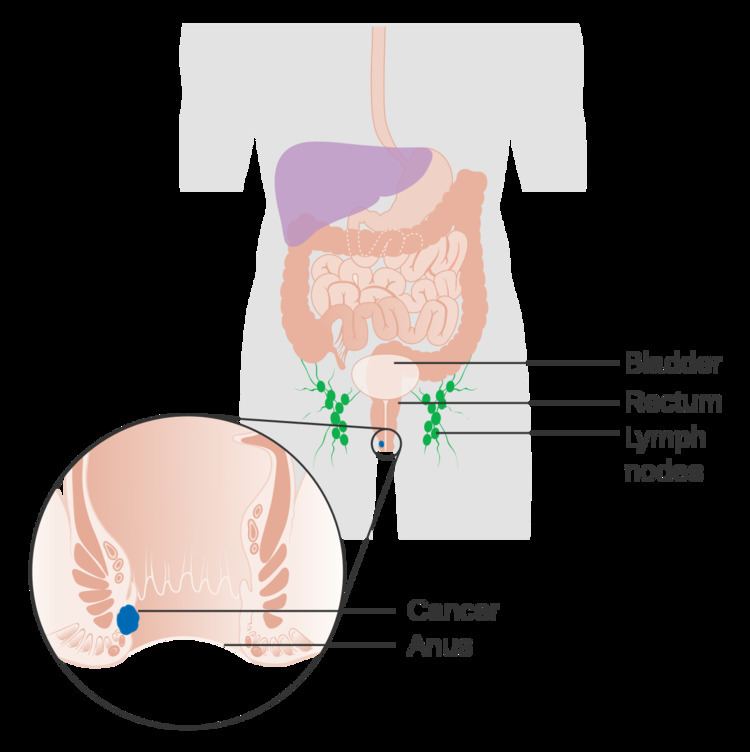DiseasesDB 31467 | ICD-10 C21 MeSH D001005 | |
 | ||
Anal cancer is a cancer (malignant tumor) which arises from the anus, the distal opening of the gastrointestinal tract. It is a distinct entity from the more common colorectal cancer.
Contents
- Signs and symptoms
- Risk factors
- Pathology
- Prevention
- Screening
- Localised disease
- Metastatic or recurrent disease
- US
- UK
- Worldwide
- References
Anal cancer is typically an anal squamous cell carcinoma that arises near the squamocolumnar junction, often linked to human papillomavirus (HPV) infection. It may be keratinizing (basaloid) or non-keratinizing (cloacogenic). Other types of anal cancer are adenocarcinoma, lymphoma, sarcoma or melanoma. From data collected 2004-2010, the relative five year survival rate in the United States is 65.5%, though individual rates may vary depending upon the stage of cancer at diagnosis and the response to treatment.
Signs and symptoms
Symptoms of anal cancer can include pain or pressure in the anus or rectum, a change in bowel habits, a lump near the anus, rectal bleeding, itching or discharge. Bleeding may be severe.
Risk factors
Pathology
Most anal cancers are squamous cell carcinomas (epidermoid carcinomas), that arises near the squamocolumnar junction. It may be keratinizing (basaloid) or non-keratinizing (cloacogenic).
Other types of anal cancer are adenocarcinoma, lymphoma, sarcoma or melanoma.
Prevention
Since many, if not most, anal cancers derive from HPV infections, and since the HPV vaccine before exposure to HPV prevents infection by some strains of the virus and has been shown to reduce the incidence of potentially precancerous lesions, scientists surmise that HPV vaccination may reduce the incidence of anal cancer.
On 22 December 2010, the U.S. Food and Drug Administration approved Gardasil vaccine to prevent anal cancer and pre-cancerous lesions in males and females aged 9 to 26 years. The vaccine has been used before to help prevent cervical, vulvar, and vaginal cancer, and associated lesions caused by HPV types 6, 11, 16, and 18 in women.
Screening
Anal Pap smears similar to those used in cervical cancer screening have been studied for early detection of anal cancer in high-risk individuals. In 2011, the HIV clinic at Jackson Memorial Hospital implemented a program to enhance access to anal cancer screening for HIV-positive men. Nurse practitioners perform anal Papanicolaou screening, and men with abnormal results receive further evaluation with high-resolution anoscopy. The program has helped identify many precancerous growths, allowing them to be safely removed.
Localised disease
Localised disease (carcinoma-in-situ) and the precursor condition, anal intraepithelial neoplasia (anal dysplasia or AIN) can be ablated with minimally invasive methods such as Infrared Photocoagulation.
Previously, anal cancer was treated with surgery, and in early stage disease (i.e., localised cancer of the anus without metastasis to the inguinal lymph nodes), surgery is often curative. The difficulty with surgery has been the necessity of removing the internal and external anal sphincter, with concomitant fecal incontinence. For this reason, many patients with anal cancer have required permanent colostomies.
Current gold-standard therapy is chemotherapy and radiation treatment to reduce the necessity of debilitating surgery. This "combined modality" approach has led to the increased preservation of an intact anal sphincter, and therefore improved quality of life after definitive treatment. Survival and cure rates are excellent, and many patients are left with a functional sphincter. Some patients have fecal incontinence after combined chemotherapy and radiation. Biopsies to document disease regression after chemotherapy and radiation were commonly advised, but are not as frequent any longer. Current chemotherapy consists of continuous infusion 5-FU over four days with bolus mitomycin given concurrently with radiation. 5-FU and cisplatin are recommended for metastatic anal cancer.
Metastatic or recurrent disease
10 to 20% of patients treated for anal cancer will develop distant metastatic disease following treatment. Metastatic or recurrent anal cancer is difficult to treat, and usually requires chemotherapy. Radiation is also employed to palliate specific locations of disease that may be causing symptoms. Chemotherapy commonly used is similar to other squamous cell epithelial neoplasms, such as platinum analogues, anthracyclines such as doxorubicin, and antimetabolites such as 5-FU and capecitabine. J.D. Hainsworth developed a protocol that includes Taxol and Carboplatinum along with 5-FU. Median survival rates for patients with distant metastases ranges from 8 to 34 months.
US
The American Cancer Society estimated that in 2014 about 7,060 new cases of anal cancer would be diagnosed in the United States (4,430 in women and 2,630 in men) . It is typically found in adults, average age early 60s.
In the United States, an estimated 800 to 900 people die of anal cancer annually.
UK
Anal cancer accounts for less than 1% of all cancer cases and deaths in the UK. Around 1,200 people were diagnosed with the disease in 2011, and around 310 people died in 2012.
Worldwide
Worldwide in 2002 there were an estimated 30,400 new cases of anal cancer. With approximately equal fractions in the developing (15,900) and developed (14,500) countries. An estimated 90% (27,400) were attributable to Human papillomavirus (HPV).
